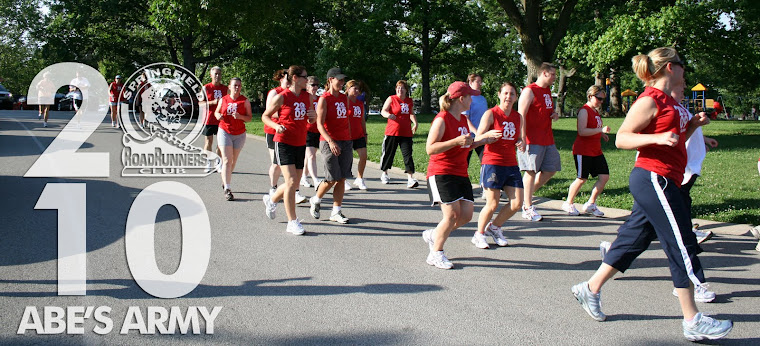After two weeks of training, you are beginning to get a feel for how challenging the Abe’s Army training is and whether you are working at the right intensity. If you went out this weekend and tried a longer walk or run of 3 to 5 miles planned for Saturday, some of you might come back from that discouraged and saying, “no way!” More about the long run in a minute, but first about finding the right training plan.
Many of you are wondering if you did the right thing to being training with Abe’s Army because you are finding out that running is hard work! It does get easier over time, but the most important thing for new walkers and runners or those returning to it after a long time away, is to find the right intensity for training. This is what I mean about doing the Abe’s Shuffle—review your current progress with your leader if you feel you might be in over your head and don’t hesitate to shuffle around to another platoon! Your leader can help you find a group of the right intensity. If you are huffing and puffing, you legs hurt or feel like lead, or you are totally exhausted after you do the walking or running exercise, you are working at too high an intensity (speed). We have all speeds for the groups and there is one right for you that will fit your needs. Don’t let yourself get frustrated and feel like quitting because this is too hard. We can help you find a training group that is challenging and fun without being overwhelming.
Now back to that long walk or run and why you shouldn’t let how fast you went determine whether you are succeeding after two weeks. The long run is part of a successful training plan. A once a week long walk or run is designed to build endurance, it is not about speed. If you are trying to go fast, you are defeating the purpose of the walk or run. The goal for this exercise session is to build distance, even if it means you need to slow down or add walking to the run. For walkers, the weekend long walk should be at a slower pace than the weekday walks. The intensity of the long walk or run should be low with a focus on completing the distance. There are two ways to measure intensity for your running. One is the RPE—Rating of Perceived Exertion, and the other is heart rate. The RPE is a self-rating of how hard the exercise is. The scale goes from 6 (very, very light) to 20 (hard, hard and exhausting). A rating of 11 is fairly light, 13 somewhat hard, 15 hard, 17 very hard, 19 very, very hard and 20 total fatigue and exhausting. New walkers and runners should aim to have their runs fall between 11 to 15 on this scale. The weekend long run should be at the lower end of this scale, at 11. If you are working harder than this, you are trying to go too fast and should SLOW DOWN! Continuing to work at too high of an intensity, especially for a long distance, will put you at risk for injuries.
The second way to gauge intensity is to monitor heart rate. Some runners do this with a heart rate monitor. But you can also check your own heart rate and calculate the intensity of the workout.
Calculating Exercise Heart Rates
First calculate your resting heart rate. This is the number of beats per minute when your body is resting. The best way to find this number is to take your heart rate before you get out of bed for three mornings in a row and average the three days’ rates.
Then calculate your maximal heart rate. The formula of 220 minus your age is the most frequent method used to determine this.
To calculate the intensity for your exercise, subtract the average resting rate from the maximal rate. This number is called the Heart Rate Reserve—the amount of heart beats per minute your heart can speed up to pump blood to your muscles and lungs during exercise. Now calculate how much of the heart rate reserve to use during your training by using the following formulas:
Easy: 50-70% of your Heart Rate Reserve
Moderate: 75-85% of your Heart Rate Reserve
Hard: 86-96% of your Heart Rate Reserve
For the final step, add the Heart Rate Reserve for each level of exercise to the resting heart rate to find your target heart rate.
Here’s the calculation for EASY training intensity at 50% that should be used for the long run:
Resting heart rate = 60
Maximal heart rate for 45 year old = 220-45 = 175
Heart Rate Reserve = 175-60 = 115
Easy Exercise Reserve = 115 x .5 = 58
Target Heart Rate for Easy Intensity = 60 + 58 = 118 beats/minute
The goal for your long run is to exercise at the low end of the easy scale or using 50% of your Heart Rate Reserve. You can monitor this rate by slowing to a walk or stopping briefly and counting your pulse at the wrist for 10 seconds and multiplying by 6 to get total beats per minute. If your heart rate is faster than the target heart rate, slow down or add walking intervals to your run.
Questions about running intensity? Post them here in the comments or bring them to your leaders this Tuesday. Until then:
Smile when you run!
Subscribe to:
Post Comments (Atom)

No comments:
Post a Comment